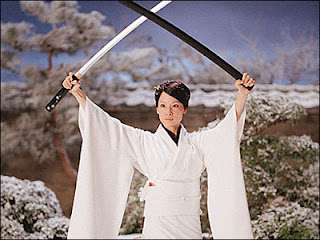After watching Kill Bill Volume 1 in more depth there are various observations i have made about representation of gender in thrillers, though I am aware Kill Bill Volume 1 is more an action film than a thriller. The bride challenges the traditional representations of women in thriller films due to her being the centre of the action, unlike traditional representations of women in noir thrillers. Anna in Carol Reed's 'The Third Man' who is never the centre of the action and Eve in Sergio Leone's 'Once Upon A Time In America' who is shot dead in the opening sequence. The bride could also be related to Detective Mill's wife in David Finchers 'Se7en'. She is called Tracy Mills. Tracy is not in the action of the film and is a passive character just like Anna and Eve.
- At the start of Kill Bill Volume 1 Tarantino uses a shot utilising the rule of thirds (this shot is pictured above) This shot is a low angle close up shot of the feet of a man assumed to be Bill. After watching the film I realise that this shot is replicated a second time in the film. This is when the town Sheriff discovers the bodies and the bride dead within the church.
- The linear structure within Kill Bill Volume 1 has a non-linear and jumps around from year to year frequently.
- The penultimate fight scene is presented to the audience in many ways. There are sections in black and white suggests that Tarantino is paying tribute to noir films such as Carol Reed's 'The Third Man'. There is also a section in which all the characters are silhouetted. This is to make the fight scene more interesting and not just one massive brawl for the audience to tolerate.
- A second reason why Tarantino utilises black and white is because of the gory nature of the scene. Black and white is used as to not disgust/disturb the audience. The same principle applies for the section silhouetting the characters.
- In the end scene O-ren Ishii wears a white a robe. The reason why she wears white is because it can connote to vunerability contradicting her very harsh and stern exterior. Another reason why the white kimono (traditional Japanese robe) is worn by O-ren Ishii (as seen below) is because it makes a contrast between the two characters of O-ren and the bride. The brides tracksuit is yellow. This can represent decay and ageing. It is also covered in blood following the fight scene with the crazy 88 compared to O-ren's which is pristinely clean. This also shows her personality and the fact that she never likes to get her hands dirty which is why she has her own personal army of the crazy 88.
- At the start of each chapter a soundbridge is used. This keeps the audiences attention yet also helps the continuity of the film by letting it 'flow'.
- Kill Bill Volume 1 ends on a breath-taking cliff hanger. The situation is the alleged character of 'Bill' asking his accomplice 'Sofie Fatale' the question of:
"Is she aware that her daughter is still alive?" - After doing some background research I have discovered that 'Hattori Hanzó' is not an original character from the mind of Tarantino. Hattori Hanzó (known as the man from Okinawa) is actually a character from a Japanese television series broadcasted in 1980 called 'Kage No Gunda' (pronounced car-gay-no-goon-dar). This translates as 'Shadow Warriors'.
The fight scenes in Kage No Gunda are very similar to the end fight scene in Kill Bill Volume 1 e.g. taking place in a traditional dojo looking building. - Tarantino cunningly manages to fit in two very different styles into K.B.V.1. These two styles being:
Spaghetti Western
Japanese Fighting Films.
These are two very different styles. An example of how vast the gap is between them is the costume. Below is an example of the two styles of costume.
- Above are a traditional pair of cowboy boots and a 'ten gallon' cowboy hat worn in the early scenes of the film by the sheriff and deputy. Below are the styles of clothes worn by the Japanese oriental characters:
- An inspiration for Quentin Tarantino for K.B.V.1 was a film produced in 1973 called 'Lady Snowblood' directed by Toshiya Fujita. This was a Japanese samurai revenge movie which was a large influence on Tarantino for this K.B.V.1. Lady Snowblood translates into Japanese as 'Shuravaukihime'.
- The three piece, all girl band called 'The 5, 6, 7, 8's' star in K.B.V.1 just before end fight scene as seen below:

- Tarantino first heard this band playing over the PA system in a clothes shop in Japan and bought the CD off of the shop just before he flew back home.







You have done some interesting research about where Tarantino draws his ideas. Kill Bill Volumes 1 & 2 though action films also draws on the kung foo genre films and Japanese samurai films. I like the name Sophie Fatale a tongue in cheek reference to the thriller femme fatale archetype.
ReplyDeleteI've googled "Inter textual references in Kill Bill Volumes 1 & 2" and found some interesting sites. One site "Kill Bill References Guide" would interest you: Examples from the guide:
References to WESTERN Movies (American & Italian
References to HORROR, Splatter films and Gialli
References to American and European Cinema (Mainstream and Exploitation)
References to Japanese cinema
References to Chinese cinema
References to TV shows or anime
References to Tarantino's OWN movies